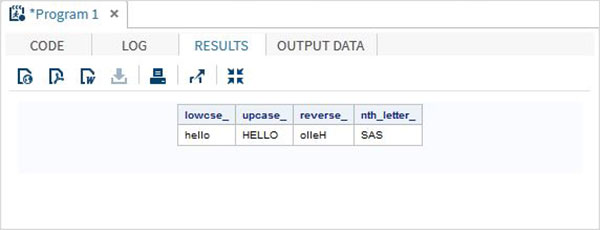SAS - ฟังก์ชั่น
SAS มีฟังก์ชันในตัวที่หลากหลายซึ่งช่วยในการวิเคราะห์และประมวลผลข้อมูล ฟังก์ชันเหล่านี้ใช้เป็นส่วนหนึ่งของคำสั่ง DATA พวกเขารับตัวแปรข้อมูลเป็นอาร์กิวเมนต์และส่งคืนผลลัพธ์ที่เก็บไว้ในตัวแปรอื่น จำนวนอาร์กิวเมนต์ที่ใช้อาจแตกต่างกันไปขึ้นอยู่กับประเภทของฟังก์ชัน บางฟังก์ชันยอมรับอาร์กิวเมนต์เป็นศูนย์ในขณะที่บางฟังก์ชันยอมรับจำนวนตัวแปรคงที่ ด้านล่างนี้คือรายการประเภทของฟังก์ชันที่ SAS มีให้
ไวยากรณ์
ไวยากรณ์ทั่วไปสำหรับการใช้ฟังก์ชันใน SAS มีดังต่อไปนี้
FUNCTIONNAME(argument1, argument2...argumentn)ที่นี่อาร์กิวเมนต์อาจเป็นค่าคงที่ตัวแปรนิพจน์หรือฟังก์ชันอื่น
หมวดหมู่ฟังก์ชัน
ขึ้นอยู่กับการใช้งานฟังก์ชั่นใน SAS แบ่งออกเป็นด้านล่าง
- Mathematical
- วันและเวลา
- Character
- Truncation
- Miscellaneous
ฟังก์ชันทางคณิตศาสตร์
นี่คือฟังก์ชันที่ใช้ในการคำนวณทางคณิตศาสตร์กับค่าตัวแปร
ตัวอย่าง
โปรแกรม SAS ด้านล่างนี้แสดงการใช้ฟังก์ชันทางคณิตศาสตร์ที่สำคัญบางอย่าง
data Math_functions;
v1=21; v2=42; v3=13; v4=10; v5=29;
/* Get Maximum value */
max_val = MAX(v1,v2,v3,v4,v5);
/* Get Minimum value */
min_val = MIN (v1,v2,v3,v4,v5);
/* Get Median value */
med_val = MEDIAN (v1,v2,v3,v4,v5);
/* Get a random number */
rand_val = RANUNI(0);
/* Get Square root of sum of the values */
SR_val= SQRT(sum(v1,v2,v3,v4,v5));
proc print data = Math_functions noobs;
run;เมื่อรันโค้ดด้านบนเราจะได้ผลลัพธ์ต่อไปนี้ -

ฟังก์ชันวันที่และเวลา
นี่คือฟังก์ชันที่ใช้ในการประมวลผลค่าวันที่และเวลา
ตัวอย่าง
โปรแกรม SAS ด้านล่างแสดงการใช้ฟังก์ชันวันที่และเวลา
data date_functions;
INPUT @1 date1 date9. @11 date2 date9.;
format date1 date9. date2 date9.;
/* Get the interval between the dates in years*/
Years_ = INTCK('YEAR',date1,date2);
/* Get the interval between the dates in months*/
months_ = INTCK('MONTH',date1,date2);
/* Get the week day from the date*/
weekday_ = WEEKDAY(date1);
/* Get Today's date in SAS date format */
today_ = TODAY();
/* Get current time in SAS time format */
time_ = time();
DATALINES;
21OCT2000 16AUG1998
01MAR2009 11JUL2012
;
proc print data = date_functions noobs;
run;เมื่อรันโค้ดด้านบนเราจะได้ผลลัพธ์ต่อไปนี้ -

ฟังก์ชั่นตัวละคร
นี่คือฟังก์ชันที่ใช้ในการประมวลผลค่าอักขระหรือข้อความ
ตัวอย่าง
โปรแกรม SAS ด้านล่างนี้แสดงการใช้ฟังก์ชันอักขระ
data character_functions;
/* Convert the string into lower case */
lowcse_ = LOWCASE('HELLO');
/* Convert the string into upper case */
upcase_ = UPCASE('hello');
/* Reverse the string */
reverse_ = REVERSE('Hello');
/* Return the nth word */
nth_letter_ = SCAN('Learn SAS Now',2);
run;
proc print data = character_functions noobs;
run;เมื่อรันโค้ดด้านบนเราจะได้ผลลัพธ์ต่อไปนี้ -

ฟังก์ชันการตัดทอน
นี่คือฟังก์ชันที่ใช้ในการตัดทอนค่าตัวเลข
ตัวอย่าง
โปรแกรม SAS ด้านล่างนี้แสดงการใช้ฟังก์ชันการตัดทอน
data trunc_functions;
/* Nearest greatest integer */
ceil_ = CEIL(11.85);
/* Nearest greatest integer */
floor_ = FLOOR(11.85);
/* Integer portion of a number */
int_ = INT(32.41);
/* Round off to nearest value */
round_ = ROUND(5621.78);
run;
proc print data = trunc_functions noobs;
run;เมื่อรันโค้ดด้านบนเราจะได้ผลลัพธ์ต่อไปนี้ -

ฟังก์ชันเบ็ดเตล็ด
ตอนนี้ให้เราเข้าใจฟังก์ชั่นเบ็ดเตล็ดของ SAS พร้อมตัวอย่างบางส่วน
ตัวอย่าง
โปรแกรม SAS ด้านล่างแสดงการใช้ฟังก์ชันเบ็ดเตล็ด
data misc_functions;
/* Nearest greatest integer */
state2=zipstate('01040');
/* Amortization calculation */
payment = mort(50000, . , .10/12,30*12);
proc print data = misc_functions noobs;
run;เมื่อรันโค้ดด้านบนเราจะได้ผลลัพธ์ต่อไปนี้ -
